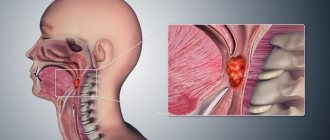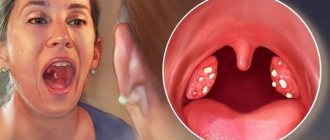06.08.2021
If we talk about the most common reasons for visiting an otolaryngologist, diseases of the throat and larynx are, perhaps, only superior to a runny nose. In most cases, patients struggle with unpleasant symptoms on their own, which often leads to complications and chronic forms of pathologies.
There are many causes of throat and larynx diseases. The lion's share of them are the consequences of the activity of bacteria and viruses, which have similar symptoms to fungal and tumor diseases. There are throat diseases without elevated body temperature; their appearance is provoked by allergens, dry air and substances that irritate the mucous membrane.
Signs and causes
Most diseases of the throat and larynx are infectious in nature. The causative agents are bacteria, viruses and fungi.
The most common bacterial
throat disease - sore throat. Its appearance is caused by streptococci, chlamydia, mycoplasmas, gonococci and tubercle bacilli. Scarlet fever, diphtheria and epiglottitis are also caused by bacteria. All three diseases are manifested by a sore throat, and epiglottitis is generally life-threatening as it can lead to airway obstruction.
Symptoms of bacterial diseases:
- general weakness;
- swelling of the larynx, tonsils;
- high body temperature;
- pain and discomfort in the throat.
For viral
diseases, a sore throat can be one of the symptoms of an illness, for example, ARVI, influenza or measles. Infectious mononucleosis caused by the Epstein-Barr virus (herpes type IV) stands apart. Its development is dangerous due to the rapid spread of inflammation to the spleen and liver, which in turn leads to enlargement of the lymph nodes.
Viral diseases are similar in symptoms:
- heat;
- prostration;
- headache;
- general weakness;
- runny nose;
- cough;
- rash;
- pain and sore throat.
Fungal diseases
genesis - a consequence of the active activity of yeast-like fungi, which looks like a cheesy mass on the mucous membrane during tonsillitis or pharyngitis. Symptoms of a fungal infection of the throat:
- severe sore throat;
- the temperature remains normal.
Fungi quickly multiply in the body during disorders of the gastrointestinal tract, against the background of vitamin deficiency, abuse of antibiotics and hormonal drugs.
A special place as a cause of pain in the throat and larynx is occupied by tumors. It can be primary, that is, formed for the first time, or it can be secondary, the result of metastasis of oncological processes in other parts and organs of the body. The larger the tumor, the more discomfort it brings: the voice changes, becoming hoarse, a feeling of a lump appears in the throat, and it becomes difficult to swallow.
What to do?
Of course, says the ENT doctor, every person can look into his own throat with the help of an ordinary flashlight and mirror. However, you should not turn into your own doctor, warns Vladimir Zaitsev. “Because, for example, the use of antibiotics where it is not required, but antiseptics are needed, can seriously harm. For the same pharyngomycosis, the use of antibiotics will further suppress the flora and allow more active growth of fungi. It is also dangerous not to use antibiotics where they are required. And only a doctor can determine exactly what exactly, in what situation and what courses will be required,” says Vladimir Zaitsev. This means that if you experience a sore throat, an in-person examination and the prescription of adequate therapy are required.
There are contraindications. Be sure to consult your doctor.
Treatment of diseases of the throat and larynx
For any form of the disease, frequent and abundant drinking and rinsing is recommended; this allows you to “wash away” the waste products of viruses and bacteria, relieve inflammation and maintain the mucous membrane in the desired shape (it tends to dry out due to high body temperature during illness).
Most cases respond well to drug treatment if it is started on time. Surgical intervention is sought when purulent or tumor processes begin, that is, the disease takes on a severe form, threatening the patient’s life with suffocation.
What and how to treat:
- ARVI is the most common throat disease. It is characterized by dry throat, sore throat, runny nose, sneezing and coughing. The temperature usually stays between 37–38 degrees. Treated with antiviral drugs based on existing symptoms. Gargling with infusions of chamomile, sage and herbal lozenges helps with sore throat; they relieve irritation and make the treatment pleasantly tasty. Along with this, it is recommended to take vitamin C to support and strengthen the immune system, as well as plenty of warm drinks (herbal teas with honey are welcome);
- tonsillitis is an infectious-allergic disease that mainly affects the tonsils. It is characterized by high body temperature, up to 40 degrees, and unbearable pain in the throat. The larynx and tonsils are red - a sure sign of an inflammatory process - and have a white coating. High fever is accompanied by aching joints and headache. Treatment is prescribed by a doctor, since it is important to prevent complications. Drinking plenty of fluids, gargling with antiseptic herbs, and herbal lozenges help with a sore throat. Food should be taken pureed and liquid, not hot, so as not to injure damaged areas of the mucous membrane;
- pharyngitis is an acute inflammatory process in the pharynx, with a characteristic dry cough, soreness, stabbing pain, a feeling of a lump and inflammation in the mucous membrane, developing into purulent processes. During illness, all solid, spicy, sour and hot foods are excluded from the patient’s diet. Treatment is medicinal, the doctor prescribes antiseptics, since the disease is inflammatory in nature. Self-medication in this case is strictly prohibited: the disease develops quickly and becomes chronic;
- laryngitis - inflammation of the vocal cords and larynx is characterized by a barking cough with sputum, a hoarse voice until its complete disappearance, and a scratching pain in the throat. Children often suffer from laryngitis. Laryngitis causes swelling of the throat when lying down, which can lead to suffocation. Therefore, if you find that your child begins to choke while lying in bed, call an ambulance, lift the child to an upright position and take him to the bathroom, under a warm shower, to relieve the spasm. Laryngitis is treated with inhalations, warm compresses, warm drinks and silence. To alleviate the patient's condition, high humidity is needed in the room: a container of water, a diffuser or a wet towel on a radiator;
- Tonsillitis is an inflammation of the tonsils, which is characterized by high body temperature, acute sore throat, and bad breath due to purulent plaque on the tonsils. The main causes of tonsillitis are viruses and bacteria. The course of treatment includes gargling with a solution of soda and salt - it acts as an antiseptic and “washes away” the pus.
Bacterial throat diseases develop very quickly, within a few hours. Viral ones - a little slower. But only a doctor can determine the real etiology of the disease, and then only based on test results.
Relieving throat muscle tension during neurosis
Tension of the throat muscles during neurosis causes breathing problems. In the complex treatment of neurosis of the pharynx and larynx, breathing exercises can give good results. It helps relieve spasm and tension in the respiratory muscles, restore breathing rhythm, reduce the dosage of medications, and speed up the healing process. You need to take an active short breath and a natural passive exhalation. The air should be inhaled through the nose, making a short, strong movement, and exhaled through the mouth.
The breathing movement and inhalation must coincide in time. The rhythm of breathing movements should correspond to the rhythm of the march. Breathing exercises for throat neurosis can be done standing, sitting or lying down. Their effectiveness improves in fresh air. To determine the cause and type of throat neurosis, exclude the organic nature of the disease and undergo a course of effective therapy, call the contact center of the Yusupov Hospital.
Prevention
It is impossible to ensure that your throat never hurts, especially in the autumn-winter period. But prevention can be carried out regularly to reduce the risk of illness and strengthen the immune system. For this:
- stop smoking if you smoke - nicotine irritates and dries out the mucous membrane of the nose and throat, making them vulnerable to pathogens;
- eat a varied and nutritious diet so that the body receives vitamins and minerals in full;
- humidify the indoor air - artificial indoor fountains, aquariums, diffusers, and water containers are suitable for this. Too dry air is a strong irritant to the throat and contributes to the appearance of microtraumas on the mucous membrane;
- wash your hands more often - pathogenic bacteria, as a rule, enter our body from dirty hands;
- take vitamins - they support the immune system;
- dress according to the weather - during hypothermia, blood vessels narrow, which destroys the protective mechanism of the mucous membrane and the person catches a cold. The cold itself does not contribute to this;
- do not self-medicate - there is a high risk of complications, for example, in the form of hearing loss or disease of the ears, lungs, eyes or brain.
If you feel unwell, consult a doctor. You can make an appointment with a multidisciplinary medical otolaryngologist using the feedback form or by calling.
Diagnosis of throat neurosis at the Yusupov Hospital
In order to establish the cause of throat neurosis, doctors at the Yusupov Hospital conduct a comprehensive examination of the patient. Using radiography of the cervical spine, osteochondrosis is detected or excluded. More accurate information is obtained after a computed tomography scan of the spine. Patients undergo laboratory tests (general and biochemical blood tests, thyroid hormone levels).
In order to exclude the organic nature of the disease, doctors perform magnetic resonance and computed tomography of the throat. A comprehensive examination includes Doppler ultrasound of the vessels of the brain and neck, and electromyographic study. Patients are consulted by an otolaryngologist, neurologist, vertebrologist, and psychotherapist.
Anatomy of the throat
In the pharynx and larynx, as well as at the border of the oral and nasal cavities along the back wall of the pharynx, there are accumulations of lymphoid tissue - the lymphoid-pharyngeal ring. It performs a protective function and is an important organ of our immunity. The largest collections of lymphoid tissue are called tonsils and there are several of them: two palatine, two tubal, one pharyngeal (aka adenoid) and one lingual.
Below is the larynx - this is a complex organ, representing a complex of various tissue structures, consisting of several cartilages, muscles, with a developed network of blood, lymphatic vessels and nerves.
Tonsillitis and its features
Tonsillitis is also a common type of throat disease. The acute form of this pathology is more often called tonsillitis, and the chronic course is characterized by sluggish inflammation of the tonsils. The cause of such a throat disease as tonsillitis is most often bacteria (staphylococcus), and the frequency of exacerbations and the intensity of inflammation depends solely on the resistance of the immune system.
The development of tonsillitis can be caused by diseases such as scarlet fever (red tonsils, crimson tongue, rash on the body with a small dot), mononucleosis (tonsils, liver, spleen are significantly enlarged, monocytes are increased in the blood test), enterovirus infection (dyspeptic disorders, fever body).
Examination, the appearance of the sore throat and the patient’s complaints are usually sufficient symptoms to make a diagnosis. If necessary, the issue of taking a smear from the throat mucosa for bacteriological examination is decided.
What does the doctor think?
“In patients with chronic tonsillitis, tonsillitis occurs 10 times more often than in practically healthy people.”
Diagnosis of laryngopharyngeal cancer
How to diagnose throat cancer in the early stages? If there are symptoms of throat cancer, diagnosis should be comprehensive. Doctors at the Yusupov Hospital diagnose cancer of the throat and larynx using the following methods:
- Direct and indirect laryngoscopy,
- Hypopharyngoscopy;
- Computed tomography;
- Histological examination;
- Trial laryngofissure;
- Cytological examination of prints from the larynx and lymph nodes;
- Determination of tumor marker levels.
How to recognize throat cancer? Otolaryngologists first perform indirect laryngoscopy. When examining the true vocal cords, attention is paid to their mobility during phonation and the asymmetry of the lesion inherent in the tumor process, and the size of the tumor lesion and its location are specified. To examine the posterior parts of the larynx, they are examined with a laryngeal mirror from bottom to top, when the doctor sits in front of a standing patient.
How to diagnose throat cancer in an elderly person if the picture is not clear enough or if the tumor is masked by secondary inflammatory phenomena with decay, infiltration and edema? In this case, otolaryngologists resort to local anesthesia, elevating the epiglottis, palpating with a probe, using a magnifying mirror, and also tilting the patient’s head accordingly. If a lesion of the subglottic region or lower parts of the pharynx is suspected, direct laryngoscopy and hypopharyngoscopy are used.
How to check your throat for cancer using computed tomography. This research method expands diagnostic capabilities for tumors that are localized in the area of the ventricular and true vocal cords and laryngeal ventricles, as well as when the tumor has spread to the subglottic region. At the Yusupov Hospital, patients are examined using the latest generation computer tomographs with high resolution capabilities.
How to check the throat and larynx for cancer using laboratory methods? Histological examination determines the nature of the tumor, its structure, the degree of differentiation of cellular elements and the degree of malignancy of the tumor - all these details influence the course of the disease and are taken into account when choosing a treatment method
To avoid stimulation of increased growth and spread of the tumor process due to damage to the lymphatic and blood vessels during biopsy, oncologists perform several sessions of radiation therapy before surgery.
How to diagnose laryngeal cancer using other methods? In cases where the biopsy data are not convincing enough or it is impossible, a trial laryngofisure is used. Since during the procedure, contamination of surrounding tissues with atypical cells may occur, in such cases, a histological examination is urgently performed at the operating table, having previously obtained the patient’s consent for radical intervention. Cytological examination of prints from the larynx and lymph nodes is carried out in cases where the patient categorically refuses surgery and a biopsy is not indicated.
How to detect throat cancer at an early stage? For early diagnosis of throat and larynx cancer, doctors at the Yusupov Hospital examine the level of tumor markers SCC and CYFRA 21-1. Highly qualified doctors, equipping operating rooms with modern diagnostic equipment and instruments allows oncologists at the Yusupov Hospital to improve five-year survival rates for throat cancer.
How to treat laryngeal cancer? Doctors at the Yusupov Hospital have extensive experience in treating laryngeal cancer. The treatment method is selected depending on the stage of the disease, type and spread of the tumor. The following methods are used:
- Surgical interventions (chordectomy, laryngectomy);
- Organ-preserving laser surgery for laryngeal tumors;
- Operations to remove tumors using a shaver;
- Radiation treatment (external gamma therapy);
- Neoadjuvant, adjuvant and curative chemotherapy;
- Palliative treatment.
Expert opinion
Author: Alexey Andreevich Moiseev
Head of the Oncology Department, oncologist, chemotherapist, Candidate of Medical Sciences
Throat cancer accounts for 3% of all cancers. At the same time, the tumor is the most common among neoplasms of the upper respiratory tract. It is diagnosed in 50–70% of cases. As throat cancer progresses, permanent disability occurs. As a result, the tumor remains a problem for clinical medicine.
Recently, in Russia there has been an increase in the number of newly diagnosed throat cancers. This is due to the influence of external and internal factors. Around the world, the statistics are no less comforting. Every year 15,000 new cases of pathology are diagnosed. The ratio of sick men to women is 1000:8.
The Yusupov Hospital provides a full course of diagnostics necessary to identify pathology even at the formation stages. The earlier the examination is performed, the more favorable the prognosis. The quality of treatment meets international standards. An individual therapy and rehabilitation program is developed for each patient, aimed at improving the quality of life and preventing relapse.
The main treatment method for laryngeal cancer is surgery. Radical surgical intervention for a malignant tumor is removal of the larynx. The consequences may vary. After surgery, some patients lose their voice and tumor growth resumes.
A laryngofissure is applied when the exophytic tumor is localized on the free edge of the anterior two-thirds of the true vocal cord, without the tumor spreading to the anterior commissure and the arytenoid region.
If a significant area of the larynx is affected by the cancer process, and mobility in the affected area is very limited or even completely absent, the process is macroscopically one-sided, surgeons perform throat surgery for oncology - resection of half of the larynx. Hemilaryngectomy is indicated not only for internal cancer that does not grow through the cartilage of the larynx, but also when the tumor process has spread to the anterior commissure and the area of the arytenoid cartilage.
If the tumor is localized in the anterior two-thirds of one true vocal cord with transition to the anterior commissure or even to the anterior part of the other true vocal cord, a half resection of the larynx according to Otan is performed. During this operation, the anterior parts of the larynx are removed, leaving its posterior wall. After the intervention, swallowing and voice function are preserved. Partial surgical interventions for laryngeal cancer include frontal resection of the larynx. It is used for damage to the anterior commissure.
Currently, the most common organ-preserving operations for localized laryngeal cancer remain chordectomy and diagonal resection of the larynx. After surgery, patients' voice function is impaired; they note hoarseness, fatigue during conversation, and a significant deterioration in sound when overloaded. An undesirable consequence of sagittal resection of the larynx is a disorder in swallowing after surgery.
How to cure throat cancer at an early stage? Laryngeal surgery (tumor removal) is performed using a shaver. During the operation, healthy tissue is not injured. The operation is performed endoscopically. A tracheostomy for laryngeal cancer is performed after total removal of the organ. The Yusupov Hospital provides nutrition after removal of the larynx for throat cancer.
Throat cancer is treated with anticancer drugs. Oncologists practice two treatment options: monotherapy and polychemotherapy. In monotherapy, one drug is used, to which cancer cells are especially sensitive. The drug is prescribed in large doses. For polychemotherapy, several cytostatic drugs are used sequentially or simultaneously.
Chemotherapists at the Yusupov Hospital use combinations of cytostatics recommended by the International Association of Oncologists to achieve the greatest effectiveness of treatment. They use drugs that are highly effective and have minimal side effects. Patients at the Oncology Clinic have the opportunity to receive the latest anticancer drugs thanks to a research program in which the Yusupov Hospital participates. The effectiveness of radiation therapy for throat cancer is assessed by professors and doctors of the highest category.
A combined approach to the treatment of laryngeal cancer can improve treatment results. Radiation therapy for throat cancer is used both as primary treatment and as part of combination therapy. Is there a cure for throat cancer? Most patients with early stages of laryngeal cancer are cured with radiotherapy. How suitable radiation therapy for laryngeal cancer is for a particular patient depends on the volume and location of the tumor, and is determined by the depth of its growth in the throat tissue.
In the early stages of the disease, treatment in most cases is carried out with radiation sessions 5 times a week for 3-7 weeks. The radiotherapist calculates the total radiation dose to laryngeal cancer for the entire course, and then divides it into fractions. This separation allows you to reduce the undesirable consequences of treatment. Can throat cancer be cured? If complex treatment is started on time, the prognosis for recovery improves many times over.











